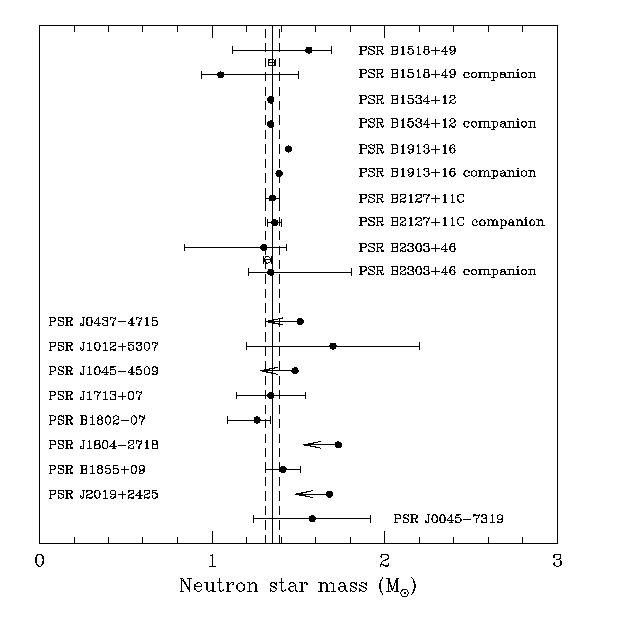
Neutron star masses from Max Camenzind.
| MadSci Network: Astronomy |
The maximum mass that a star can have without turning into a black hole is called the Chandrasekhar limit. The exact value of this limit is not known accurately because it depends on various factors. The composition of the star or its rotation speed can change the Chandrasekhar limit. If the star is not rotating fast, and is composed of normal matter, the Chandrasekhar limit is around 1.4 solar masses. Stars that are below this limit are called white dwarfs and neutron stars. These stars are highly compressed spheres because the gravitational force shrinking the star is not balanced with the expanding pressure from energy produced by nuclear reactions. These incredibly compressed stars are really dead in the inside. They shine because of nuclear reactions on their surface. The Chandrasekhar limit of a white dwarf is about 1.4 solar masses. Slightly more mass will produce a reaction that turns electrons and protons into neutrons. The result is a supernova explosion and possibly a neutron star. The Chandrasekhar limit of a neutron star has been estimated to be around 1.5 solar masses by different physicists like Norman K. Glendenning at the Lawrence Berkeley National Laboratory ( Phys.Rev. C , Vol. 64, Article 025801, 2001). I disagree with the value of 3 to 3.2 solar masses for the Chandrasekhar limit of a neutron star quoted by the "Ask an Astrophysicist" NASA site (see below).
Astronomers have been looking hard to find white dwarfs or neutron stars with high masses. Measuring star masses is very difficult. Accurate masses have been measured for a few dozen stars. The highest measured mass for a white dwarf was estimated at 1.33 solar masses by a team of astronomers from Hawaii, Germany and Brazil in 2007 (Kepler, Kleinman, Nitta, Koester, Castanheira, Giovannini, Costa and Althaus Monthly Notices of the Royal Astronomical Society , Vol. 375, Pag. 1315, 2007).
The highest neutron star mass is 1.7 solar masses, but this measurement has a large possible error. The true mass for this star, known as PSR J1012+5307, could be anywhere between 1.15 and 2.2 solar masses. Strikingly all measured neutron star masses cluster around 1.4 solar masses as shown in the diagram below, taken from Prof. Max Camenzind's site at:
http://www.lsw.uni-heidelberg.de/users/mcamenzi/NS_Mass.html
This means that neutron stars always form with nearly the same mass. Just another puzzle for astronomers to solve!

Neutron star masses from Max Camenzind.
As far as escaping gravity from a white dwarf or a neutron star, there is another thing to consider: the size. Light cannot escape a black hole because of the gravitational attraction on its surface. In order to turn into a black hole, a star must shrink below the Schwarzschild radius which is given in miles as 1.9 times the mass of the star in solar masses. Thus a neutron star with 1.5 solar masses must shrink to a sphere less than 2.85 miles in radius to become a black hole. If the star is bigger than that, many things will be able to escape. White dwarfs tend to be the size of Earth, so they have much to go in shrinking before they turn into black holes. That is why white dwarfs can expell a lot of material.
Greetings from,
Vladimir Escalante Ram�rez
Center for Radio Astronomy and Astrophysics
National University of Mexico, Morelia, Mexico
Try the links in the MadSci Library for more information on Astronomy.